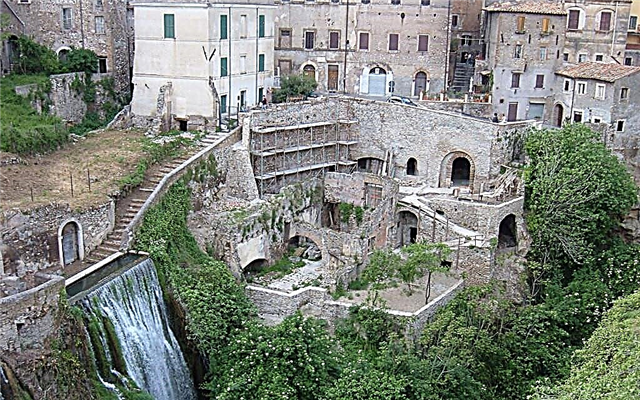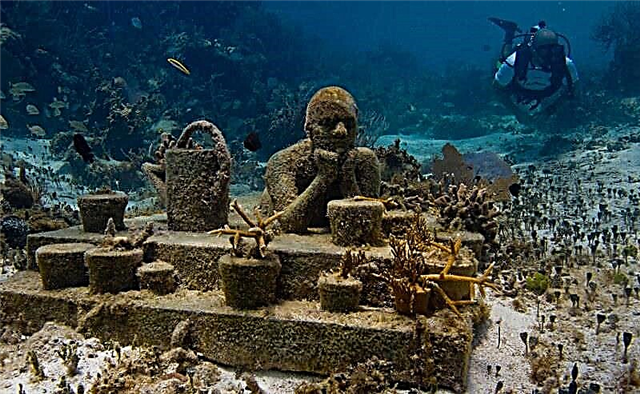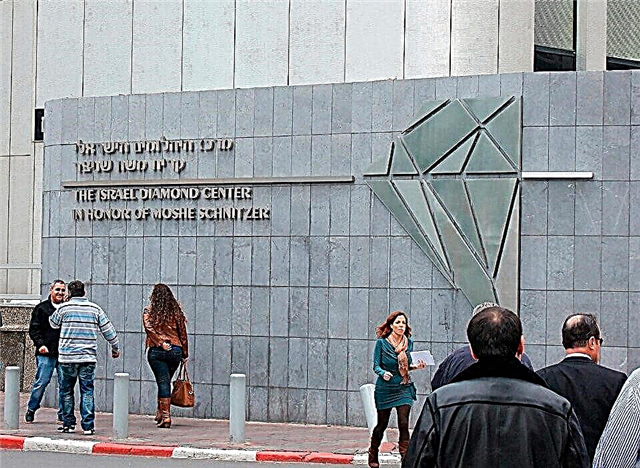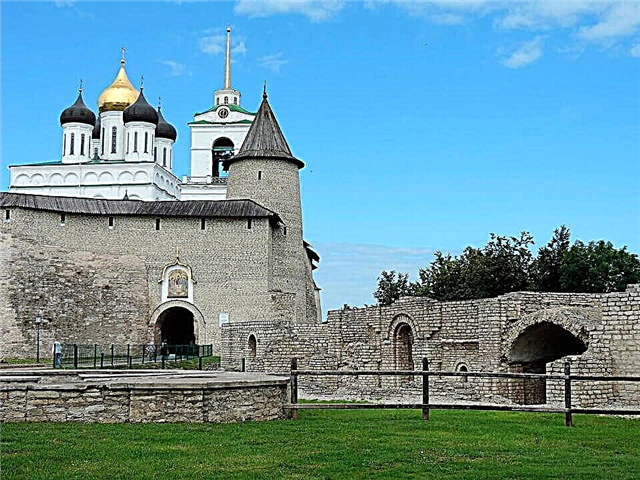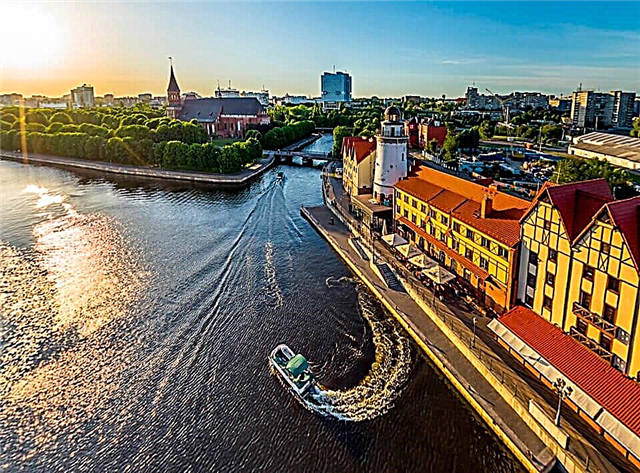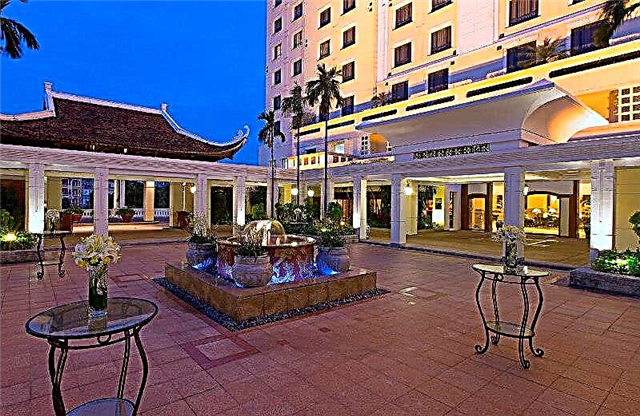The Pokrovsky Monastery owes its appearance to a miracle. According to legend, the Suzdal-Nizhny Novgorod prince Andrei Konstantinovich sailed from Nizhny Novgorod to Suzdal, and a terrible storm fell on his boat.
Short story
The prince vowed that if he survived, he would build a monastic monastery in Suzdal. Andrey Konstantinovich kept his promise: in 1364, in the lowland of the right bank of the Kamenka River, the Intercession Convent was founded... The original wooden buildings of the monastery have not survived. The current ensemble was formed in the 16th century, when the monastery turned into a place of imprisonment for the disgraced wives of the Russian tsars.

Scheme of the Intercession Monastery
One of his first prisoners was the wife of Vasily III, Solomoniy Saburova. The Grand Duke married Solomonia in 1505, choosing her at the bride from 500 brides presented to the court for this purpose. The couple lived in peace and harmony for 20 years, but Saburova never gave birth to an heir to the throne. Accusing his wife of infertility, Vasily III decided to dethrone (that is, divorce) and remarry the Lithuanian beauty Elena Glinskaya. In 1525, at the behest of Vasily III, Solomon was forcibly tonsured into a monk under the name of Eldress Sophia and was exiled to the Suzdal Pokrovsky Monastery.
Solomonia resisted, cried and screamed, and when the monk's doll was brought to her, she began to trample on it with her feet. One of the boyars even hit the princess with a whip, exclaiming: "How dare you oppose the will of the sovereign!" Saburova replied that she did not want to be tonsured, and that God sees everything and will take revenge on her persecutor. All ecumenical patriarchs condemned the dissolution of the grand duke's marriage.

Pokrovsky Monastery from a bird's eye view
Angry, Vasily III deprived Metropolitan Varlaam of the clergy, which happened for the first time in Russian history. And the Patriarch of Jerusalem, Mark, predicted to the prince that if he marries a second time, he will “have an evil child” who will amaze the world with his cruelty. The prediction came true: Ivan the Terrible was born from the marriage of Vasily III and Elena Glinskaya. Several months passed, and suddenly rumors spread throughout Russia that Solomonia was already pregnant at the time of her tonsure and gave birth to Tsarevich George in the Intercession Monastery. According to legend, the boy was secretly brought up in forest monasteries, and, having matured, became the famous robber Kudeyar. Solomonia, fearing murderers who might have been sent by Vasily's second wife, announced that the newborn had died and staged a funeral. 400 years later in 1934, during the reconstruction of the Intercession Monastery, a tombstone was discovered, under which lay a rag doll, dressed in a shirt embroidered with pearls.

View of the buildings of the Intercession Monastery
Today this find is kept in the historical exposition of the Suzdal Museum. According to some researchers, the undershirt is indirect evidence that Saburova did have a child. But nothing is known about the real fate of Ivan the Terrible's elder brother, the legitimate heir to the throne. Saburova, a monastic sister Sophia, died 17 years after taking the tonsure and was buried in the basement of the Intercession Cathedral. Ivan the Terrible himself allegedly laid on Sophia's coffin a shroud sewn by his wife Anastasia. Already under Tsar Theodore Ioannovich, the son of the Terrible, Sophia was revered as a saint. To this day, pilgrims come to the Intercession Monastery to venerate the relics of Sophia of Suzdal, asking the saint for healing and the gift of children. Following the example of Vasily III, the princes and boyars also exiled their wives to the Pokrovsk monastery. In the tomb of the Intercession Cathedral, the wife of Ivan the Terrible, Anna Vasilchikova, the wife of Peter I, Evdokia Lopukhina, the first wife of Prince Vladimir Andreyevich Staritsky and other noble women, found eternal peace.
The architectural ensemble of the Pokrovsky Monastery
1. Intercession Cathedral

View of the Cathedral of the Intercession of the Most Holy Theotokos (Pokrovsky Cathedral)
The panorama of the main church of the Intercession Monastery appears before the viewer in all its glory from the opposite left bank of the Kamenka River. The construction of a stone cathedral in honor of the Intercession of Our Lady began in 1510 at the behest of Vasily III on the site of an older wooden temple. By 1518, among the low monastic cells, a new cathedral was erected, standing on a high basement floor. The monumental, four-pillar temple is surrounded on three sides by a two-storey open gallery, to which two porches lead from the north-west and south-west. From the east, the building is adjoined by a three-apse altar part with narrow high window-slits. The apses are divided among themselves by smooth columns and are surrounded by a carved cornice with a small pattern. The walls of the cathedral, decorated with an arcature-columnar belt, are completed with keeled zakomaras, from which three powerful drums grow, crowned with helmet-shaped gilded domes.

The interior decoration of the Intercession Cathedral was initially distinguished by the asceticism of decoration: the white walls that did not have paintings created a striking contrast to the floor, paved with black ceramic tiles. The interior was decorated with icons and artwork made by nuns.
At the bottom of the walls there are small niches for storing church books, icons and other items of church worship. Currently, especially valuable icons of the Intercession Cathedral are kept in the Russian Museum in St. Petersburg.
2. Tent bell tower

Hipped bell tower
The hipped bell tower, adjacent to the Pokrovsky Cathedral from the south-west, is connected to it by a covered gallery. The lower plastic, powerful part of the bell tower with wide angular blades was built in 1515. This wide octagonal pillar, once crowned with a cupola, was used as a church in the name of "The Origin of the Honest Trees of the Cross." In the 17th century, an arched tier of bells and a slender tent, completed with three rows of auditory openings, were built over the temple. The covered gallery, which connects the belfry and the cathedral, is magnificently decorated with rustic wood and windows with graceful frames. In the belfry there is a bell from 1589, granted by the nobleman Demid Cheremisin to the Intercession Monastery.
3. The Holy Gates with the Church of the Annunciation

Gate Church of the Annunciation
In the southern wall of the fence was the main entrance to the Intercession Monastery - the Holy Gates with the Church of the Annunciation above them, built around 1515 by order of Vasily III. The Holy Gates combine elements of serf and religious architecture. The lower part of the building, made in the form of a tower, has a passable arch. The upper part of the massive quadrangle is occupied by a three-domed church, whose decor resembles the Intercession Cathedral.
Its facades are covered with a pattern consisting of rollers, curbs and widths of various sizes. The central head of the church rests on a massive drum raised on a tier of kokoshniks. At the corners of the temple are two miniature side-chapels, crowned with drums with helmet-shaped domes. According to legend, the chapel of the Grand Duchess Saburova was located in the southeastern aisle. The main façade of the church faces Stromynka, the main Moscow road. On this road, high-ranking guests from Moscow came to the Suzdal Pokrovsky Monastery, including Ivan the Terrible, who brought valuable gifts to the monastery.
4. Conception refectory church

View of the Conception Refectory Church
To the north of the Intercession Cathedral is the Conception Refectory Church, originally consecrated in the name of the conception of St. Anna. In 1551, on the site of a wooden church, Ivan the Terrible erected a stone church in memory of his deceased daughter Anna.
The Church of the Conception resembles a civil building: its basis is a rectangular refectory, covered with a gable roof.From the south-west to the refectory chambers there is a hexagonal clock belfry, and from the east - the actual volume of the church, indicated by a small cupola. The building is decorated with diamond-shaped ornaments made of fine bricks, typical of Polish rather than Russian architecture. Perhaps the architect of the Church of the Conception was a Polish master invited by Elena Glinskaya. The second floor of the building houses a spacious refectory with powerful vaults resting on a single pillar. The lower floor is occupied by a bakery, a cookery and other utility rooms.
5. Prikaznaya hut, or the house of judgment

Prikaznaya hut, or the house of judgment
In the southwestern part of the Suzdal Pokrovsky Monastery there is an order hut. The elongated rectangular building consisted of three rooms: the northern one was occupied by the archive, the central one was occupied by the patrimonial office, and in the extreme southern room the guilty nuns and peasants brought here for arrears were interrogated. The patrimonial office was headed by a clerk, who managed the monastic economy. Today, the building has an exposition that recreates the interior of the clerk's hut of the late 17th century.... Under the command hut there is a basement - a prison "bag" measuring 2x4 meters, where the prisoners were kept.
6. Towers of the monastery
The Intercession Monastery is surrounded by a stone fence with towers. In the northern part of the monastery there is the oldest part of the fence (17th century), which together with the hipped towers forms a separate courtyard.

Monastery towers
The octahedron towers built in the 18th century look more elegant: they are crowned with hemispherical domes and dissected into tiers by horizontal rods.
Attraction rating:

